Romantic Brugges (11/05/03)
Last updated 11/30/03
Brugges is the most romantic town
a girl can have the good luck of visiting with her true love.
Everywhere she turns her head, she will see winding medieval streets,
lovely 3-story houses with triangular rooftops, turrets and towers,
canals and bridges, palaces and windmills. Lace shops are as abundant
as chocolate and candy stores, a lively produce market takes place
(quite appropriately) on the Markt square, the bells toll the hour on
the belltower of the city hall, the moon leans over to admire its
reflection in the Lover's Lake at night, the white swans move proudly
among fallen leaves in the water of the canals, horses pull ornate
carriages on the cobbled pavement, the windmills spread their arms to
embrace you as a dear guest, impress Brugges on your soul, and never
let romance find its way out of your life.
Brugges is truly incredible in its fairy-tale appearance, quaint
old-fashioned ways, and sheer romantic atmosphere. Where else could you
walk the streets, taking random turns, and keep seeing a gothic castle
here, a medieval town gate there, a windmill over on your left, a
lovely curved bridge up ahead? Where else could you order a simple cup
of tea at a cafe and be brought a silver tray with the tea kettle, a
jug of hot milk, a chocolate on the side, whipped cream and ice cream?
Where else can the fall season put spring back in your heart, where
else can you breathe the stuff of dreams? Imagine Disneyland the way
you saw it as a child, with not a single fake note in it; Brugges is
like that, but better.
If you find yourself in Belgium, be sure to come to Brugges and just
walk without regard to maps and sight-seeing. When you've had your fill
of fairy tales, walk it all over again and pause in a few places of
interest. Markt square has the Belfry tower with a carillon of 47 bells
that plays wonderful tunes; the government palace of neo-gothic 19th
century style is also here, as are multiple pricey cafes that provide a
great view of the square and the public market taking place here on
most days. Brugges also has a daily fish market that you may want to
avoid if aromas of fresh fish and seafood may spoil the romantic mood
for you. The nearby Burg square has the City Hall, a gothic
14th-century building, the Renaissance structures of the Old Recorder's
House and the Old Country House (16th century), and the baroque
17th-century Provost's House. All of them are administrative buildings,
but you wouldn't know that from looking at them -- royal palaces is
what comes to mind.
Do not miss another building, much less impressive on the exterior but
rich in history: House Ter Beurze on Vlamingstraat 35, where local and
foreign merchants came together to make deals and negotiate prices. The
name of the mercantile clan who owned the house (Van der Beurze) gave
rise to the Dutch word "beurs", meaning "exchange house", "trading
place", which was imported into many European language to mean "stock
exchange". Thus, the first stock exchange in the world was located here
in Brugges, back in the day when the town was an important commercial
and industrial center, instead of a sleepy touristy place. Here's an
abridged version of Brugges history for you... From the 11th century
until 1604, Brugges was an international commercial port, having access
to the sea via a canal that later silted up, cutting off sea trade. In
the middle ages Brugges produced high-quality cloth for export all over
Europe, and was known for its lace. In the 15th century, the province
of Flanders passed to the Burgundian state, and Brugges became the
favourite residence of the Dukes of Burgundy, under whom arts and
banking flourished here. By the end of 15th century, the golden age of
Brugges was over, although it kept its position as a centre of luxury
good production and arts into the period of Spanish domination. Ruled
by Austria, then France, then Netherlands, Brugges became increasingly
more poor, and only revived its reputation as a city of arts and has
grown as a tourist center in late 20th century, and has been named to
the list of World Heritage by the UNESCO in 2000.
When walking around Brugges, make your way to Minnewater -- the Lake of
Love, which is equally mesmerizing in full daylight or on a moonlit
night. The park of the same name is nice for strolling hand-in-hand
with your significant other, but then again, isn't all of Brugges? Be
sure to get to the outskirts of the old town where the town gates still
stand: Smedenpoort (Blacksmith's Gate; notice the small skull hanging
on it as a reminder of treachery of a Ghent citizen who in 1688 let the
French invaders in through the gates), Gentpoort, Kruispoort (Cross
Gate) and Ezelpoort (Donkey's Gate). These old city gates used to be
part of the medieval ramparts around Brugges from 13-14th century, and
now they are connected by a greenbelt -- a ring of parks and canals.
Beyond Kruispoort on the east end of town one will see several
windmills, one of which is sometimes still in use.
Don't forget to stop at some cafe or "tea salon" for Belgian waffles
and wonderful chocolate creations of Brugges!
Pictures
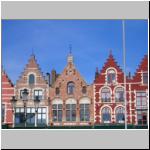

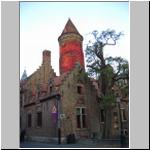
 Typical buildings, every one so pretty!
Typical buildings, every one so pretty!
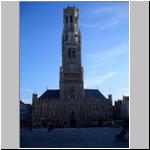
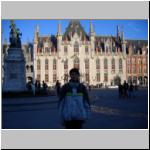
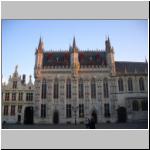
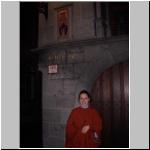 On and around Markt square
On and around Markt square
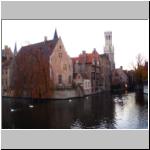
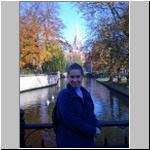
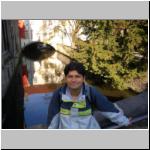
 Brugges as a little northern Venice
Brugges as a little northern Venice
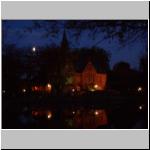
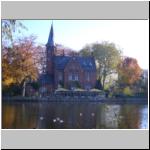

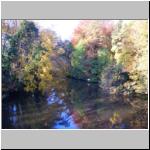 More water views: lakes and ponds
More water views: lakes and ponds
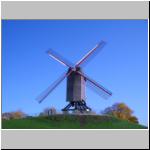
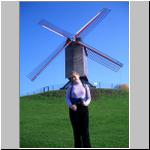
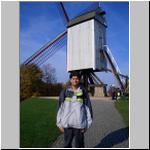
 Windmills in Brugges
Windmills in Brugges



 Typical buildings, every one so pretty!
Typical buildings, every one so pretty!


 On and around Markt square
On and around Markt square


 Brugges as a little northern Venice
Brugges as a little northern Venice


 More water views: lakes and ponds
More water views: lakes and ponds


 Windmills in Brugges
Windmills in Brugges